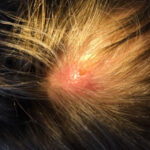Are you seeing those tiny pests swarming around your kitchen? You might be dealing with fruit flies. Don’t worry; they’re common and easy to eliminate with simple, cost-effective methods. Flyermedia.net is here to guide you through creating your own fruit fly traps using ingredients you likely already have. Learn about the best methods for fruit fly control and prevention, including fruit fly bait, and get your home pest-free.
1. Understanding Fruit Flies
What exactly are these tiny nuisances that suddenly appear in your kitchen?
Fruit flies are small, flying insects drawn to sweet, ripe, or fermenting substances. They’re attracted to fruits, vegetables, sugary drinks, beer, wine, and even garbage cans and drains. These pests are about the size of a rice grain, resembling small, tan or brownish houseflies with red eyes. According to the University of California, Riverside, fruit flies are most prevalent during the warmer months when fruits are abundant.
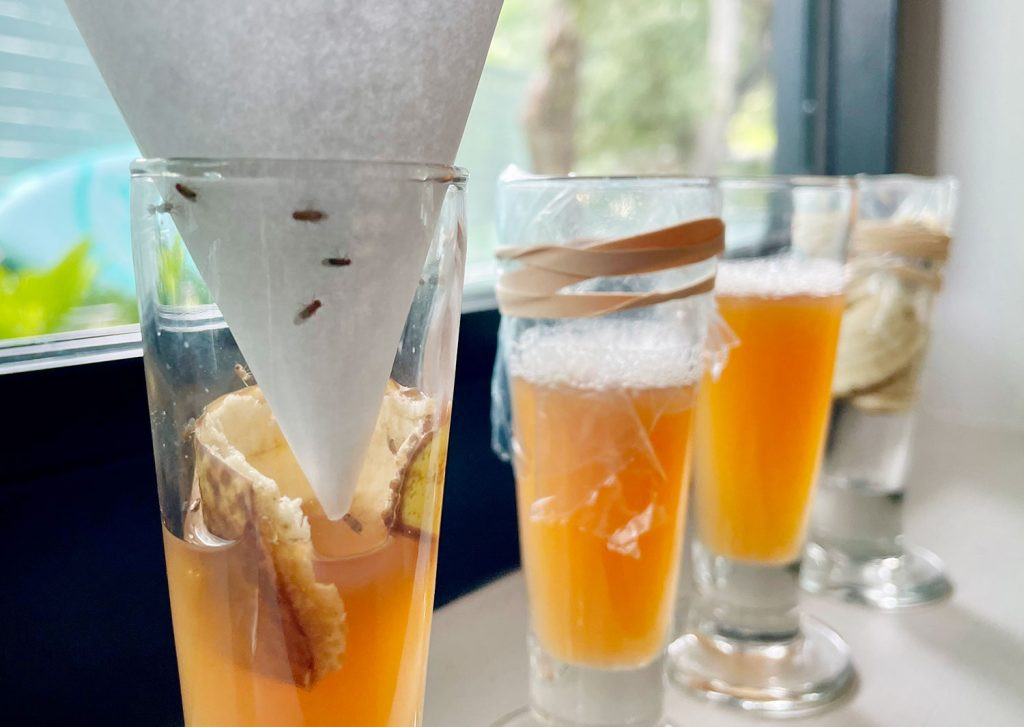 Fruit Flies Trapped In DIY Funnel Trap Method
Fruit Flies Trapped In DIY Funnel Trap Method
1.1. The Fruit Fly Life Cycle
How do a few fruit flies turn into a full-blown infestation so quickly?
The life cycle of a fruit fly is incredibly rapid. A female can lay hundreds of eggs, which hatch in as little as 12 hours. These larvae mature into adults in just a few days, leading to a rapid population explosion. The University of Florida’s Entomology and Nematology Department emphasizes that controlling fruit flies requires quick action due to their fast reproductive rate.
1.2. Fruit Flies vs. Fungus Gnats vs. Drain Flies
How can you tell the difference between these common household pests?
It’s easy to mistake fruit flies for other small flying insects, especially fungus gnats and drain flies. The easiest way to differentiate them is by where you spot them and what larger insect they resemble:
- Fruit flies look like small flies. They’re found near fruit bowls, trash, or other smelly food sources.
- Drain flies look like small fuzzy moths. They’re typically found near sinks and drains.
- Fungus gnats look like small mosquitos. They’re typically found near houseplants, since they breed in damp soil.
If you’re unsure, you can try one of the traps below and if it attracts the pests in your home, you’ve got fruit flies.
2. DIY Fruit Fly Traps: Simple and Effective Solutions
Ready to tackle your fruit fly problem with items you already have at home?
These traps work on a simple principle: attract the fruit flies and then prevent them from escaping. Here are four easy DIY methods you can try:
2.1. Funnel Fruit Fly Trap
How does this trap lure and capture fruit flies?
This trap uses a paper funnel to guide fruit flies into a container filled with an attractant. The narrow opening makes it difficult for them to escape.
Supplies needed:
- Small clear jar, cup, or container, preferably with a small or narrow opening
- Piece of paper or cardstock
- Tape
- Scissors
- Apple cider vinegar (ACV)
Instructions:
- Choose your container. Find a small (preferably clear) container like an old food jar or plastic soda bottle. For this method, it’s easier if it has a small or narrow opening.
- Add apple cider vinegar. Pour a little bit of apple cider vinegar, old beer, or wine into the bottom of the container. The smell will attract the fruit flies.
- Make your funnel. Wrap a small piece of paper or cardstock into a cone shape with a very small opening at the tip. Secure the shape with tape. You can also cut this opening at the end if that’s easier. It only needs to be about the size of a grain of rice.
- Set your funnel. Place your paper cone into the opening of your container. You may need to reshape your funnel so it’s wide enough to rest on top of the opening of your container without touching the ACV. Make sure it rests firmly against all edges of the opening, so flies can’t escape through any gaps.
- Optional outdoor ending. Bring the entire contraption outside carefully without moving the funnel (or they’ll all escape before you make it out the door) and then remove the funnel and let them fly away.
2.2. Plastic Wrap Fruit Fly Trap
How does plastic wrap help trap these pesky insects?
This trap uses plastic wrap with tiny holes to trap fruit flies inside a container filled with an attractant.
Supplies needed:
- Small clear jar, cup, or container
- Rubber band
- Plastic wrap or plastic bag
- Toothpick
- Apple cider vinegar (ACV)
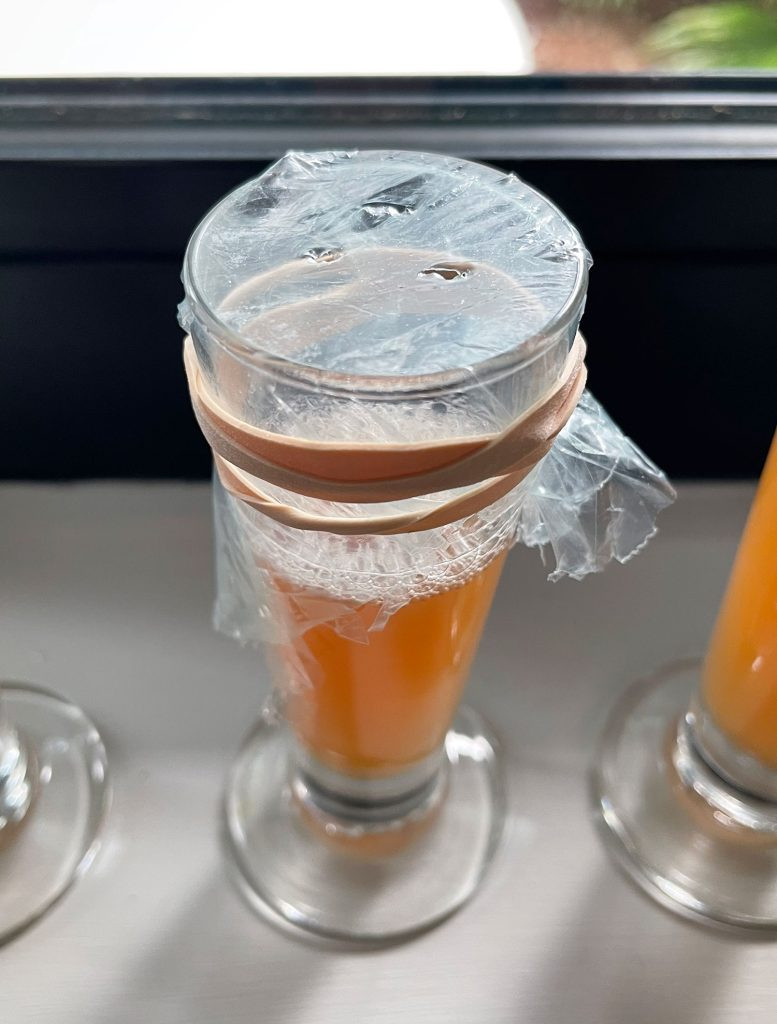 DIY Fruit Fly Trap With Apple Cider Vinegar And Plastic
DIY Fruit Fly Trap With Apple Cider Vinegar And Plastic
Instructions:
- Choose your container. Find a small clear, jar, cup, or other glass container. Just about anything works and it doesn’t need to be large. Using something clear makes it easier to see the flies your trapping, but an old soda or beer can works too.
- Add apple cider vinegar. Pour apple cider vinegar into your container. The scent will attract the flies. Old beer or wine also works too, but not regular white vinegar.
- Cover with plastic. Wrap the opening tightly with plastic wrap and secure it with a rubber band. Saran wrap works, but you can also cut scraps from a plastic bag.
- Poke small holes. Use a toothpick to poke a few small holes in the top of the plastic. You don’t need a lot, but make sure they are big enough for a fly to fit through.
- Optional outdoor ending. Bring the entire contraption outside carefully without removing the plastic wrap cover (or they’ll all escape before you make it out the door) and then remove that and let them fly away.
2.3. Dish Soap Fruit Fly Trap
How does dish soap help eliminate fruit flies?
This trap uses dish soap to break the surface tension of the liquid, causing fruit flies to drown when they land on it.
Supplies needed:
- Small container, bowl, or dish
- Dish soap
- Apple cider vinegar (ACV)
Instructions:
- Put out some apple cider vinegar. Like the other traps, fill the bottom of a small container, bowl, or dish with apple cider vinegar. This scent will attract the fruit flies.
- Add dish soap & mix. Squirt several drops of dish soap into the ACV and mix to create a soapy solution. Flies will land on the mixture but then find it difficult to fly away.
2.4. Rotting Fruit Trap
Can fruit itself be used as bait in a fruit fly trap?
This trap uses overripe fruit to attract fruit flies, luring them into a container where they can’t escape.
Supplies needed:
- Small glass jar, cup, or container
- Plastic wrap or paper funnel, depending on your chosen trap mechanism
- A small fruit scrap like a banana peel or apple slice
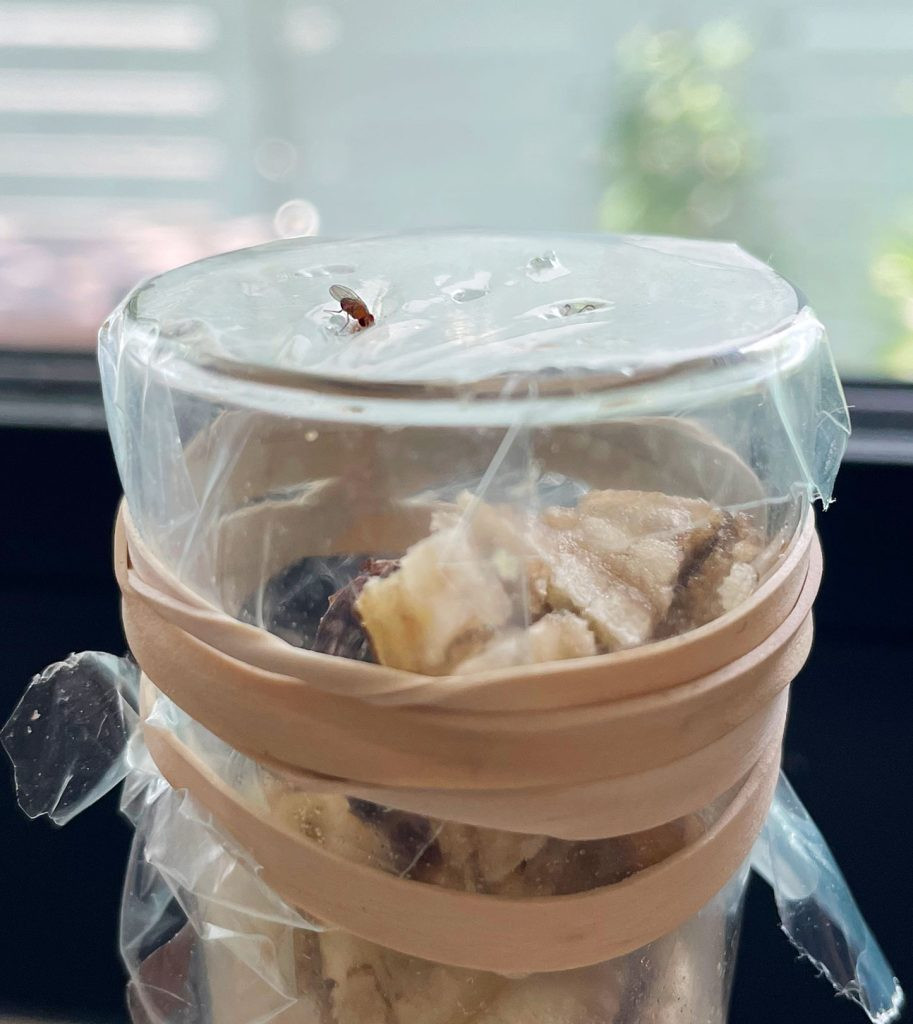 Fruit Fly Entering Plastic Wrap On DIY Trap
Fruit Fly Entering Plastic Wrap On DIY Trap
Instructions:
To create a rotting fruit trap, just substitute apple cider vinegar for a piece of banana peel, apple slice, or peach in either the Plastic Wrap or Funnel trap. You can also add this fruit scrap to your ACV as well. Just be prepared to swap out your fruit scrap every day or two so you don’t introduce unwanted smells to your kitchen.
3. Finding the Best Fruit Fly Trap: Experiment Results
Which trap works best for catching fruit flies?
After testing various methods, it was found that the type of lure used was more important than the type of trap. Traps with banana peels consistently outperformed those with apple cider vinegar.
The four homemade traps tested were a combination of techniques. They were:
- Plastic Wrap Trap with banana peel
- Funnel Trap with ACV + banana peel
- Plastic Wrap Trap with ACV + soap
- Dish Soap Trap with ACV
The two Plastic Wrap Traps were nearly identical, but the one with the banana peel dramatically outperformed the one with the ACV + soap. Maybe ACV is less enticing when there’s real fruit nearby?
4. What is the Best Attractant for Fruit Flies?
What kind of bait is most irresistible to fruit flies?
To determine the best bait, a test was conducted using banana peels, apple slices, and a strawberry in separate plastic wrap traps.
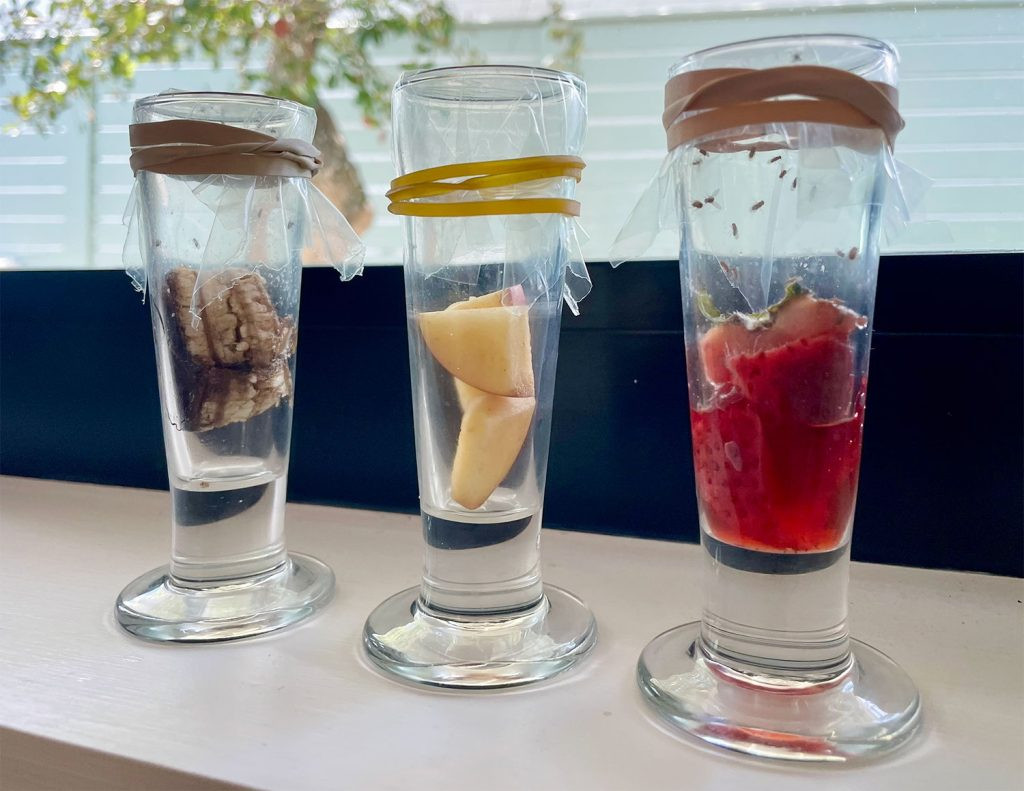 Fruit Fly Traps With Different Rotten Fruit Baits
Fruit Fly Traps With Different Rotten Fruit Baits
The strawberry proved to be the most effective attractant. Although the banana peel started off strong (it was the most rotten at the beginning), the fruit flies ended up being the most attracted to the strawberry. The banana peel still snagged several flies, but the longer the strawberry rotted, the more flies it caught. The apple slices didn’t catch a single one
5. Store-Bought Fruit Fly Traps: A Convenient Alternative
Are store-bought traps a viable option for fruit fly control?
If DIY isn’t your thing, or you want a more discreet solution, there are several effective store-bought options available.
During our little experiment, I picked up a pack of Terro Traps to see if they performed better than my homemade methods. I left one out for 24 hours next to our banana & strawberry traps to see which of the three performed best.
Once again, our homemade strawberry trap did best, followed closely by the homemade banana peel trap. The storebought trap caught only one. HOWEVER…
Just to be sure, we discarded both of our DIY traps and left the storebought trap out for another 24 hours. That’s when it caught the collection you see above. So it definitely worked, just not as well or as fast as our homemade traps did. Our verdict? Use storebought traps if you want something more discreet looking, especially if you plan to leave it out indefinitely… but there is nothing bad about the homemade ones, in fact we found them to be the best way to get the fruit flies right away
6. Preventing Fruit Flies: Keeping Your Home Pest-Free
How can you stop fruit flies from invading your home in the first place?
Prevention is key to avoiding fruit fly infestations. Here are some simple steps you can take:
- Clean kitchen surfaces. Wipe down kitchen counters, stovetops, tables, and any other surfaces that may collect food residue or spilled liquids. Fruit flies are especially attracted to fruit, sweet juices, and alcohol so don’t let those sit
- Take out your trash. Leaving food scraps in your garbage overnight can quickly turn your trash can into a fruit fly breeding ground.
- Dispose of overripe fruit. Monitor your fruit bowl for browning or rotting apples, bananas, etc so you can get rid of them before they become a problem.
- Wash your fruit as soon as you get it home. You can eliminate eggs or larvae that might come home from the store by washing produce right away (except for berries, which could rot faster from the moisture).
- Store produce in the fridge when possible. Fruit flies won’t flourish in the cold, so when in doubt, try storing your fruit and vegetables in the refrigerator.
- Clean your sink drain. Food scraps left in your drain can also attract fruit flies, so make sure you run your garbage disposal and/or flush the drain regularly.
7. Advanced Fruit Fly Prevention Techniques
What are some additional strategies for keeping fruit flies away?
Beyond the basics, consider these advanced tips:
- Seal cracks and crevices: Fruit flies can breed in small cracks and crevices. Sealing these areas can eliminate potential breeding grounds.
- Use screens: Ensure that windows and doors have screens to prevent fruit flies from entering your home.
- Consider professional pest control: If you’re struggling to control fruit flies on your own, a professional pest control service can provide effective solutions.
8. Understanding Fruit Fly Behavior
What makes fruit flies tick?
Understanding their behavior can help you target your control efforts more effectively:
- Attraction to carbon dioxide: Fruit flies are attracted to the carbon dioxide that humans and animals exhale.
- Positive phototaxis: They tend to move towards light sources.
- Aggregation pheromones: Fruit flies release pheromones that attract other fruit flies, leading to infestations.
9. The Role of Sanitation in Fruit Fly Control
Why is sanitation so important in preventing infestations?
Proper sanitation is crucial because fruit flies breed in decaying organic matter. Removing these materials eliminates their food source and breeding sites.
- Regularly clean drains: Use a drain cleaner or enzymatic cleaner to break down organic matter in drains.
- Empty and clean garbage cans: Ensure garbage cans are emptied regularly and cleaned to remove any food residue.
- Clean up spills immediately: Wipe up any spills of sugary or fermented liquids to prevent attracting fruit flies.
10. How to Handle a Severe Fruit Fly Infestation
What should you do if your fruit fly problem is out of control?
In severe cases, you may need to take more aggressive action:
- Use a combination of traps: Deploy multiple types of traps to target fruit flies at different stages of their life cycle.
- Consider fogging: A fogger can kill adult fruit flies, but use it carefully and follow all safety precautions.
- Call a professional: If you’ve tried everything and still can’t control the infestation, it’s time to call a pest control professional.
FAQ: Your Questions About Fruit Flies Answered
1. What causes fruit flies in the house?
Fruit flies are attracted to ripe, rotting, or fermented foods. They can enter your home through open windows, doors, or even on fruits and vegetables brought inside.
2. Are fruit flies harmful to humans?
Fruit flies don’t bite or sting, and they don’t transmit diseases to humans. However, they can be a nuisance and contaminate food.
3. How long do fruit flies live?
The average lifespan of a fruit fly is 40 to 50 days.
4. Can fruit flies breed in drains?
Yes, fruit flies can breed in drains where organic matter accumulates.
5. What is the best homemade fruit fly trap?
A plastic wrap trap with rotting fruit, particularly a strawberry, is highly effective.
6. Do fruit flies only eat fruit?
While they are attracted to fruit, fruit flies also feed on other sugary substances, fermented liquids, and decaying organic matter.
7. How can I get rid of fruit flies overnight?
While it’s difficult to eliminate them entirely overnight, setting up multiple traps and ensuring all food sources are removed can significantly reduce their numbers.
8. Are fruit flies active during the day or night?
Fruit flies are active during both day and night.
9. Can I use vinegar to get rid of fruit flies?
Apple cider vinegar is an effective attractant, especially when combined with dish soap. White vinegar is less effective.
10. What are some natural predators of fruit flies?
Some natural predators of fruit flies include spiders, mites, and parasitic wasps.
Fruit flies can be a nuisance, but with these simple DIY traps and preventative measures, you can easily keep your home pest-free. For more tips and information on pest control and aviation, visit flyermedia.net. Dreaming of a career in the skies? Explore pilot training programs and aviation news on our site and take the first step towards your aviation dreams. Contact us at Address: 600 S Clyde Morris Blvd, Daytona Beach, FL 32114, United States. Phone: +1 (386) 226-6000 or visit Website: flyermedia.net.
